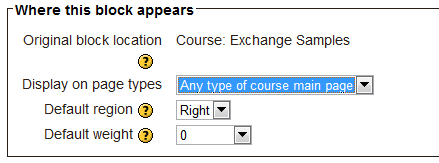Block settings: Difference between revisions
- Managing blocks
- Block settings
- Activities
- Activity results
- Admin bookmarks
- Administration
- Blog menu
- Blog tags
- Calendar
- Comments
- Community finder
- Course completion status
- Course overview
- Course/site summary
- Courses
- Feedback
- Flickr
- Global search
- HTML
- Latest announcements
- Latest badges
- Learning plans
- Login
- Logged in user
- Main menu
- Mentees
- Navigation
- Network servers
- Online users
- People
- Private files
- Quiz results
- Random glossary entry
- Recent activity
- Recent blog entries
- Remote RSS feeds
- Search forums
- Section links
- Self completion
- Social activities
- Tags
- Upcoming events
- YouTube
- Blocks FAQ
Helen Foster (talk | contribs) (Block permissions) |
Helen Foster (talk | contribs) (User profiles link) |
||
| Line 24: | Line 24: | ||
*Default weight: Where in the column do you want it to appear if there are other blocks in that column. -10 will put it at the top, 10 will put it at the bottom. A zero is neutral. | *Default weight: Where in the column do you want it to appear if there are other blocks in that column. -10 will put it at the top, 10 will put it at the bottom. A zero is neutral. | ||
[[File: Block configuration where appears.png]] | [[File: Block configuration where appears.png]] | ||
See [[User profiles]] for instructions on how to make a block appear on all user profile pages. | |||
===On this page=== | ===On this page=== | ||
Revision as of 13:12, 15 December 2011
Adding a block to a page
Blocks can be added to a page by turning editing on then using the 'Add a block' drop-down menu.
Please see Blocks for a list of all the blocks in a standard Moodle install. Your site may have added contributed blocks and or your site administrator has disabled specific blocks on your site.
Block configuration
After adding a block, click the edit icon in the block header to configure it.
Block settings
Certain blocks, such as the HTML block, allow a block title and more to be set.
File:Block configuration block setting area.png
Where this block appears
Depending upon the context and users permissions, this area determines where this block will appear.
- Original block location: provides information about where the block was initially created.
- Display on page types: allows the user to set the context that the block can appear in. These options will vary depending upon the permissions of the user. For example a site administrator might see a setting that will allow the block to appear on Any page, or any type of course main page, while a teacher may only see the option to place it on every page in the course.
- Default region: Usually a right column or left column option
- Default weight: Where in the column do you want it to appear if there are other blocks in that column. -10 will put it at the top, 10 will put it at the bottom. A zero is neutral.
See User profiles for instructions on how to make a block appear on all user profile pages.
On this page
- Visible - Yes or No.
- Region - Here you can override the column preference on this page.
- Weight - Here you can override the default setting on this page.
File:Block configuration on this page.png
Block permissions
Role permissions for a block can be changed by clicking the Assign roles icon (a face and mask) in the header of the block then via Settings > Block administration > Permissions.
See Blocks FAQ for details of how to hide front page blocks from non-logged-in users.
